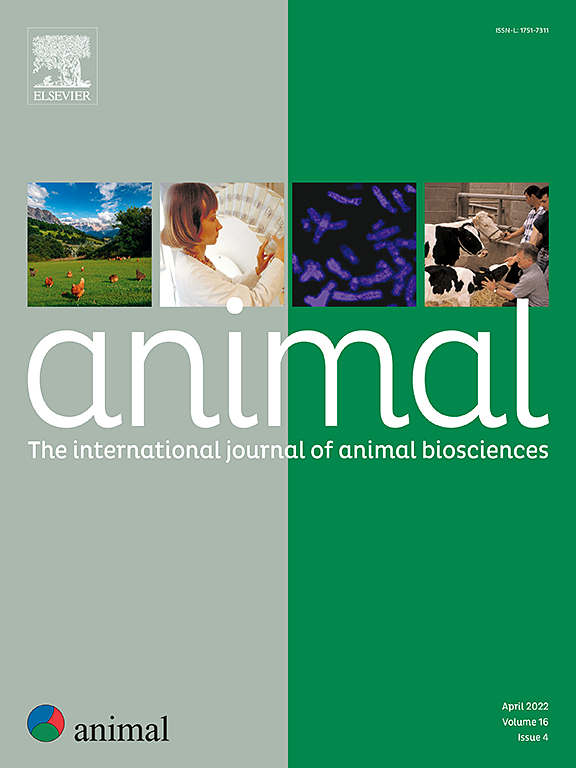早期生殖投资影响母羊的寿命
IF 4
2区 农林科学
Q1 AGRICULTURE, DAIRY & ANIMAL SCIENCE
引用次数: 0
摘要
为了提高母羊的终身产量,建议配种母羊羔羊。然而,关于初产羔羊年龄对寿命影响的研究显示出相互矛盾的结果。本研究调查了早期繁殖(即初产羔年龄和产仔数的影响)和环境条件对传统上作为羔羊饲养的多产绵羊品种寿命的影响。从2000年至2013年间出生的550884只挪威白羊中获得了终生表现数据。所有母羊在1岁或2岁时产下第一窝羊羔。使用线性混合模型研究长寿,其中包括初产羔年龄、产仔数、县、早、晚分娩协变量,以及描述交叉培养和断奶成功的两个分类变量作为固定影响。牧群x年拟合为随机效应。母羊的寿命受母羊初次繁殖时的年龄和生殖投资(即产仔数)的影响。配对为羔羊的母羊寿命为1548天(4.2年),配对为2岁母羊寿命为1700天(4.7年)。寿命与产仔数呈曲线关系。当产仔数从0只增加到1只时,寿命从1 272天(3.5年)增加到1 618天(4.4年)。繁殖投入的进一步增加导致寿命缩短,产仔4只的寿命最短,为1468天(4.0年)。产仔数与寿命的关系除母羊产仔数少于产仔数外,其余各组母羊产仔数与寿命的关系相似,但程度不同。在这组母羊中,交配为羔羊的母羊的预测寿命峰值为1504天(4.1年),产仔1只,而首次交配为2岁的母羊的预测寿命峰值为1650天(4.5年),产仔2只。寿命与生殖投资之间的关系在某些情况下受到环境条件的影响。然而,这种效应与纬度并不一致。综上所述,一般来说,与2岁时首次交配的母羊相比,母羊的寿命较短,但环境对寿命和繁殖的重要性需要进一步研究。本文章由计算机程序翻译,如有差异,请以英文原文为准。
Early life reproductive investment affects longevity in ewes
To increase lifetime production of ewes, it has been suggested to mate ewe lambs. However, research on the effect of age at first lambing on longevity has shown conflicting results. This study investigated the impact of early life reproduction (i.e., the effect of age at first lambing and litter size) and environmental conditions on longevity in a prolific sheep breed traditionally bred as lambs. Lifetime performance data were obtained from 550 884 Norwegian White Sheep born between 2000 and 2013 spread across Norway. All ewes lambed their first litter either as 1-year-old or 2-year-olds. Longevity was investigated using a linear mixed model with age at first lambing, litter size, county, the covariates early- and late parturition, and two categorical variables describing cross-fostering and success in weaning as fixed effects. Herd x year was fitted as a random effect. The lifespan of the ewes was affected both by age of the ewe at first reproduction and the reproductive investment (i.e., litter size). The predicted lifespan for ewes mated as lambs was 1 548 days (4.2 years) whereas the lifespan for those mated as 2-year-olds was 1 700 days (4.7 years). There was a curvilinear relationship between lifespan and litter size. Lifespan increased from 1 272 days (3.5 years) to 1 618 days (4.4 years) when litter size increased from 0 to 1 lamb. Further increased reproductive investment resulted in a decreased lifespan with a litter size of 4 having the shortest lifespan of 1 468 days (4.0 years). The relation between litter size and lifespan was similar but at different levels for both age groups of ewes, except for ewes rearing less lambs than they gave birth to. In that group, ewes mated as lambs had a peak predicted lifespan at 1 504 days (4.1 years) with a litter size of one lamb, whereas those first mated as 2-year-olds had their peak predicted lifespan of 1 650 days (4.5 years) with a litter size of two lambs. The relationship between longevity and reproductive investment was in some cases affected by environmental conditions. However, the effect was not consistent with latitude. In conclusion, ewes mated as lambs, in general, live shorter lives compared to those first mated as 2-year-olds but environmental importance for longevity and reproduction needs further investigation.
求助全文
通过发布文献求助,成功后即可免费获取论文全文。
去求助
来源期刊

Animal
农林科学-奶制品与动物科学
CiteScore
7.50
自引率
2.80%
发文量
246
审稿时长
3 months
期刊介绍:
Editorial board
animal attracts the best research in animal biology and animal systems from across the spectrum of the agricultural, biomedical, and environmental sciences. It is the central element in an exciting collaboration between the British Society of Animal Science (BSAS), Institut National de la Recherche Agronomique (INRA) and the European Federation of Animal Science (EAAP) and represents a merging of three scientific journals: Animal Science; Animal Research; Reproduction, Nutrition, Development. animal publishes original cutting-edge research, ''hot'' topics and horizon-scanning reviews on animal-related aspects of the life sciences at the molecular, cellular, organ, whole animal and production system levels. The main subject areas include: breeding and genetics; nutrition; physiology and functional biology of systems; behaviour, health and welfare; farming systems, environmental impact and climate change; product quality, human health and well-being. Animal models and papers dealing with the integration of research between these topics and their impact on the environment and people are particularly welcome.
 求助内容:
求助内容: 应助结果提醒方式:
应助结果提醒方式:


